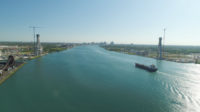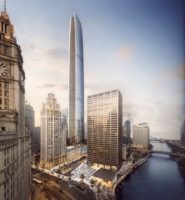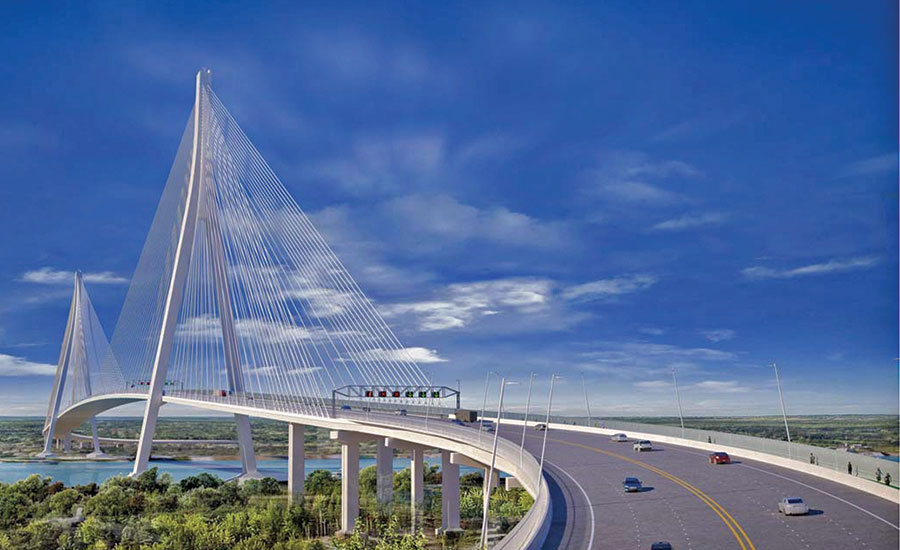Towers for $5.7-Billion Gordie Howe Bridge Will Soon Begin to Rise

The curved approach on both sides of the Gordie Howe Bridge was BNA’s design solution for staying within the existing right-of-way, a requirement from WDBA.
RENDERING COURTESY OF AECOM

On the American side of the bridge, Fluor and Malcolm prepare the ground for the caissons.
PHOTO BY JEFF YODERS/ENR

On the Canadian side of the bridge, rebar cages are prepared for eventual installation in caissons.
PHOTO BY JEFF YODERS/ENR

On the Canadian side of the bridge, site caissons are vibrated down as opposed to the American side, where oscillators are used.
PHOTO BY JEFF YODERS/ENR

As preparations continue for construction of the towers, caissons on the Canadian side have been sunk and concrete cures around the rebar.
PHOTO BY JEFF YODERS/ENR

Aaron Epstein, CEO of BNA, poses for scale with one of the large diameter drilling shafts on the American side of the river.
PHOTO BY JEFF YODERS/ENR

On the Canadian side of the river, sensors and wiring are installed on a rebar cage to monitor concrete curing.
PHOTO BY JEFF YODERS/ENR

The site requires preparation of gas and electrical lines and drainage around a web of known salt clays from previous mining that require remediation.
PHOTO BY JEFF YODERS/ENR








Much has already been written about the $5.7-billion Gordie Howe International Bridge, scheduled to open between Detroit and Windsor, Ontario, in late 2024. The new span will cross the Detroit River and provide an international crossing for truck traffic as well as an alternative to the tolled options that exist today. The bridge’s public-private partnership has been scrutinized as have the local politics surrounding the project, but the construction challenges have received far less attention.
This summer, two A-frame bridge towers to suspend the cable-stayed structure, one on the Canadian side and the other in the U.S., will start to rise 750 ft above Detroit’s skyline, as high as the city’s GM Renaissance Center. The towers will support the longest main span in North America, at 2,799 ft.
Preparation of the ground for the Bridging North America (BNA) Constructors Canada GP joint venture—which includes Dragados, Aecon, Fluor, and ACS Infrastructure—is nearing completion. AECOM was hired for design services. The full scope includes four separate projects: the bridge itself, the entry point in Canada, the entry point in the U.S. and the Michigan interchange that links the bridge to Interstate 75 and delivers six lanes of commercial traffic to businesses on both sides of the border. The Canadian work also includes customs plazas at the port of entry.
“The alignment of the bridge could not be changed,” says Jiri Filipovic, vice president of alternative delivery at AECOM Transportation and a member of the BNA design team. “It was mostly because of the former salt mining. The underground is just fraught with cavities, and significant investigations have been done to make sure that the alignment and any of the foundations don’t hit the mining cavities. So that’s why it was pretty mandatory for everyone to stay on the alignment as we had it.”
The bridge is a continuous curve, anchored at each end by the A-frame towers that suspend the bridge deck with cables across the river. The side spans are each 1,049 ft long and supported by 27 backstay cables and three pairs of ancillary piers that transfer loads directly to the ground.
The mostly serpentine approaches on each side include two sharp horizontal curves, designed that way because of the difficult ground. Remediation work has been extensive. The land is being prepared for 50,000 sq ft of buildings in addition to the bridge.
“We had to do a lot of stability work near the seawall [on the U.S. side] because [drilling subcontractor] Malcolm Drilling’s equipment is so heavy,” says Doug Thornton, general superintendent for the U.S. point of entry. He says crews drove 24-in.-dia steel reaction piles—35 of them—into bedrock to support the equipment.
“This work is existing seawall, so we’ve got to drill some shafts in between all the tiebacks and transfer the load to the backside of the anchor cap wall,” Thornton says. “Then we can clear out all these existing obstructions and be able to drill our shafts for the actual tower. So all that work is going on.”
Sitework also includes more than 150,000 wick drains for the Canadian point of entry and 105,000 for the U.S. POE to remove moisture as well as the relocation of utilities and 12 new caissons, already dug on the Canadian side. The U.S. side will soon follow, with caissons going in this year. On the Canadian side, shafts have already been dropped roughly 98 meters into the ground—six shafts per pier cap for each tower leg—with a more than 131-ft cylindrical rebar cage filled with concrete for the caissons.
Keeping track of four separate projects, each with different methods and supplies on both sides of the river, is a complex job for BNA. For example, the cost of moving fill dirt from the American side to the Canadian side is prohibitively high, and other sources of infill have to be found in Canada, says site utilities supervisor Peter Lindsay. Also, oscillators sink caissons on the U.S. side, but on the Canadian side, crews vibrate them down, Thornton says.
“One individual oversees all construction management of it,” says Aaron Epstein, CEO of BNA. “We’ve got procurement, project controls, commercial activities, business services, safety, security, all of that. We have one lead for that, for the project, and then it’s allocated amongst the various components.
“So whether it’s part of the component itself or whether it’s something we can do as a shared service with Canada, the U.S.—something more broken down into the actual four components where they need more resources—that’s how we function, overall,” he adds.
Epstein says the project is on course to make its 2024 completion and begin majority Canadian-owned BNA’s 30-year operation and maintenance period as stipulated in the P3 contract. The Windsor-Detroit Bridge Authority (WDBA) is the Canadian Crown Corp. responsible for delivery and operation of the project.
Contemporary Design
Design is being done by two separate teams to address the different building standards, but common themes include aesthetics, which must be uniform across all projects, Filipovic says.
“It had to be contemporary, minimalist and welcoming,” he says. “We wanted to have an openness by the way we used the space. Because of these common themes, both teams needed to work very closely together, and we did. On top of that, to address the various requirements for security, we brought in specialty subconsultants to supplement AECOM and the other design team members to address the different security requirements [of the Canadian and U.S. border security agencies.]”
The team had to work concurrently with both standards and meet whichever standard was the stricter of the two, whether for rebar, quality of concrete or construction methods, Filipovic says.
To keep the work on track, the design-build JV partners (Fluor, Dragados and Aecon) conduct weekly meetings and numerous ad-hoc meetings to tackle technical challenges with the DBJV and WDBA. This practice started almost immediately after the joint venture team won the project in July 2018.
“Our design life, the design leadership, obviously consisted of many meetings during the week,” Filipovic says.
Obstacles on the U.S. side included a railroad track and land to be purchased nearby. Acquiring and treating the land and rerouting the railroad had a big impact on the erection sequence on the American side.
“We had a railroad track present, and we knew that even though it was realigned, it still would not be sufficient for what we needed to do for a preferred launching sequence,” Filipovic says. “We ended up designing temporary supports and actually came out of it very well.”
Pedestrian bridges crossing 1-75 are part of the interchange project, and some existing bridges will need to be removed to make the new connection.
Sidebar: Fact Box: Four Projects in One
Bridge
Cable-stayed design
Six lanes: three Canadian-bound, three U.S.-bound
Total length: 1.5 miles/2.5 kilometers
Clear span of 0.53 mile/853 meters—the longest main span of any cable-stayed bridge in North America
Main towers will be approximately 820 ft high/250m
No piers in the water
One approach bridge on each side of the crossing to connect ports of entry in Canada and the U.S.
Once complete, the Gordie Howe International Bridge will be among the top five longest bridges in North America
A dedicated multi-use path (11.8-ft/3.6-m-wide will accommodate pedestrians and cyclists
Canadian Port of Entry
Size: 130-acre site/53 hectares
Inbound border inspection facilities for both passenger and commercial vehicles
Outbound inspection facilities
Toll collection facilities for both the U.S.-bound and Canada-bound traffic
Maintenance facility
The footprint allows for installation of further technology and the addition of expanded border-processing facilities
Once constructed, it will be the largest Canadian port along the Canada-U.S. border and one of the largest anywhere in North America
U.S. Port of Entry
Size: 167 acres/68 hectares
350,454 sq ft of building space
Inbound border inspection facilities for both passenger and commercial vehicles
Outbound inspection facilities
Commercial exit control booths
The footprint allows for installation of further technology and the addition of expanded border-processing facilities
Once constructed, it will be one of the largest ports in North America
Michigan Interchange/I-75 Connection
Four new road bridges and five new pedestrian bridges
Widened roads at key intersections to allow trucks to make full turns Four bridges crossing the railway and connecting I-75 to the U.S. POE
Reconfiguration of I-75 interchange ramps and service drives
Primary connecting ramps to and from the U.S. POE












